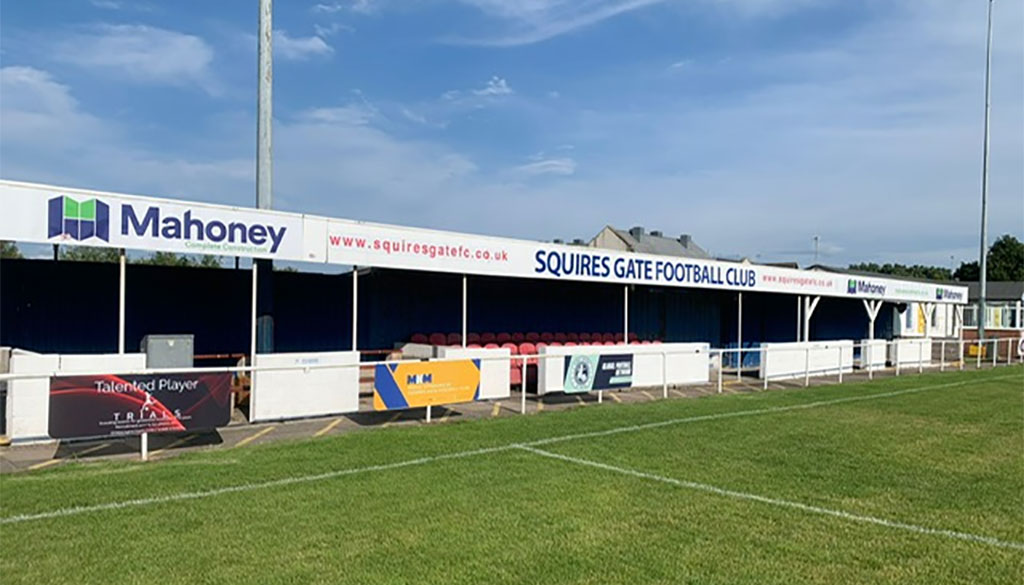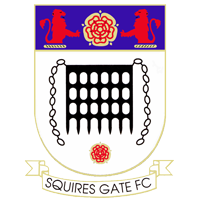
Emblematically Speaking - Squires Gate
Tue 20th February 2018 | Squires Gate | By Stewart Taylor
We all know where Squires Gate is, but to define the location exactly is useful in the context of understanding the emblem of Squires Gate FC.
If we consider the southern section of the Fylde Coast then we see running essentially north from the estuary of the River Ribble a string of towns and areas including, in order south to north, Lytham, Lytham St Annes, Squires Gate and Blackpool.
If we then look at the emblem of Squires Gate FC we note the main feature is a portcullis and, specifically, a chained portcullis.
The use of a portcullis in heraldry is well established, having been one of the devices used by the Tudor kings and queens throughout the Tudor period (1485 – 1603).
If we then consider that a portcullis, as well as being a heavy metal grille used to bar the gateway to a castle, could also be described as simply a gate. Add that to the word Squire meaning a chief landowner of, normally, a rural estate then we might just have found the origin of Squires Gate.
Some four miles or so to the south of Squires Gate FC stands Lytham Hall. This somewhat stately home has a fascinating history of which space constraints in an article of this nature prevent me going into in great detail but, in summary. Lytham Hall is now a Grade 1 listed 18th century country house built in the Palladian style but the history of a house on this site goes back quite a bit further.
Originally there was a Benedictine Priory on the site (12th century). The land and buildings were acquired in the 16th century by Sir Cuthbert Clifton and the current Lytham Hall was commissioned by Thomas Clifton.
In addition to the grand country house, the Lytham Estate consisted of extensive grounds including land which was purchased by Sir Cuthbert in nearby Great Marton. Whilst the current Lytham Hall parkland has been reduced to 78 acres, the grounds were very extensive back in the Georgian period and may well have “joined up” Lytham with Marton by-passing the coastal Lytham St. Annes.
The significance of this for our story is that Squires Gate FC is in the area of Blackpool known as Marton. From this, it is tempting to think that there was a huge long driveway up to Lytham Hall (4 miles away) from a gatehouse, protected by a portcullis, located somewhere in Marton.
This seems somewhat unlikely, particularly as there is evidence of the gatehouse having been located at Hastings Place in Lytham before being relocated to the current hall.
The Clifton family are often described as great eccentrics and travellers. There are many tales to tell but the family line came to an end in 1979 when Henry Talbot De Vere Clifton, known to his friends as Harry, died having spent his inheritance having left Lytham Hall in the hands of his creditors some years earlier. The title of Squire of Lytham now rests with James Hilton.
The remainder of the emblem takes us into more familiar territory featuring, as it does, the Red Rose of Lancaster on the purple pale at the top of the shield. This is repeated, in a slightly different representation, below the portcullis.
The two red creatures seen facing in towards the Red Rose pose something of a challenge heraldically. They appear to be lions and, specifically, demi-lions in that only half of each creature is visible. Normally when a demi-lion is used it is shown with both front legs raised (rampant) but not in this case. Equally, two demi-lions facing each other is most unusual.
As befits the identifier of a football club, the place on the emblem where a motto might reside is occupied by the name of the club.
Keen readers may well have realised that the above is based on little but speculation. It is often the case that the origins of emblems are lost in the mists of time and that a certain amount of poetic licence might be needed when attempting to explain the meaning.
In the case of Squires Gate FC we can suggest that this is almost certainly the case as no one at the club can ever remember the club emblem being any different from what it is today. Squires Gate FC have some of our longest serving volunteers, around 60 years in one case, which is quite remarkable.
Given that, should anyone out there reading this with far greater knowledge then please feel free to get in touch.
 Emblematically Speaking - Squires Gate
Emblematically Speaking - Squires Gate
Tue 20th February 2018 | Squires Gate
By Stewart Taylor

We all know where Squires Gate is, but to define the location exactly is useful in the context of understanding the emblem of Squires Gate FC.
If we consider the southern section of the Fylde Coast then we see running essentially north from the estuary of the River Ribble a string of towns and areas including, in order south to north, Lytham, Lytham St Annes, Squires Gate and Blackpool.
If we then look at the emblem of Squires Gate FC we note the main feature is a portcullis and, specifically, a chained portcullis.
The use of a portcullis in heraldry is well established, having been one of the devices used by the Tudor kings and queens throughout the Tudor period (1485 – 1603).
If we then consider that a portcullis, as well as being a heavy metal grille used to bar the gateway to a castle, could also be described as simply a gate. Add that to the word Squire meaning a chief landowner of, normally, a rural estate then we might just have found the origin of Squires Gate.
Some four miles or so to the south of Squires Gate FC stands Lytham Hall. This somewhat stately home has a fascinating history of which space constraints in an article of this nature prevent me going into in great detail but, in summary. Lytham Hall is now a Grade 1 listed 18th century country house built in the Palladian style but the history of a house on this site goes back quite a bit further.
Originally there was a Benedictine Priory on the site (12th century). The land and buildings were acquired in the 16th century by Sir Cuthbert Clifton and the current Lytham Hall was commissioned by Thomas Clifton.
In addition to the grand country house, the Lytham Estate consisted of extensive grounds including land which was purchased by Sir Cuthbert in nearby Great Marton. Whilst the current Lytham Hall parkland has been reduced to 78 acres, the grounds were very extensive back in the Georgian period and may well have “joined up” Lytham with Marton by-passing the coastal Lytham St. Annes.
The significance of this for our story is that Squires Gate FC is in the area of Blackpool known as Marton. From this, it is tempting to think that there was a huge long driveway up to Lytham Hall (4 miles away) from a gatehouse, protected by a portcullis, located somewhere in Marton.
This seems somewhat unlikely, particularly as there is evidence of the gatehouse having been located at Hastings Place in Lytham before being relocated to the current hall.
The Clifton family are often described as great eccentrics and travellers. There are many tales to tell but the family line came to an end in 1979 when Henry Talbot De Vere Clifton, known to his friends as Harry, died having spent his inheritance having left Lytham Hall in the hands of his creditors some years earlier. The title of Squire of Lytham now rests with James Hilton.
The remainder of the emblem takes us into more familiar territory featuring, as it does, the Red Rose of Lancaster on the purple pale at the top of the shield. This is repeated, in a slightly different representation, below the portcullis.
The two red creatures seen facing in towards the Red Rose pose something of a challenge heraldically. They appear to be lions and, specifically, demi-lions in that only half of each creature is visible. Normally when a demi-lion is used it is shown with both front legs raised (rampant) but not in this case. Equally, two demi-lions facing each other is most unusual.
As befits the identifier of a football club, the place on the emblem where a motto might reside is occupied by the name of the club.
Keen readers may well have realised that the above is based on little but speculation. It is often the case that the origins of emblems are lost in the mists of time and that a certain amount of poetic licence might be needed when attempting to explain the meaning.
In the case of Squires Gate FC we can suggest that this is almost certainly the case as no one at the club can ever remember the club emblem being any different from what it is today. Squires Gate FC have some of our longest serving volunteers, around 60 years in one case, which is quite remarkable.
Given that, should anyone out there reading this with far greater knowledge then please feel free to get in touch.


